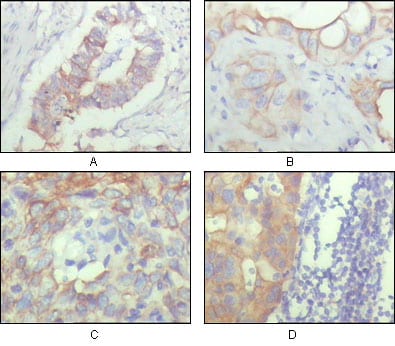
| WB | 咨询技术 | Human,Mouse,Rat |
| IF | 咨询技术 | Human,Mouse,Rat |
| IHC | 1/200 - 1/1000 | Human,Mouse,Rat |
| ICC | 技术咨询 | Human,Mouse,Rat |
| FCM | 咨询技术 | Human,Mouse,Rat |
| Elisa | 1/10000 | Human,Mouse,Rat |
| Aliases | MEMD; CD166; ALCAM |
| Entrez GeneID | 214 |
| clone | 10F1G12 |
| Host/Isotype | Mouse IgG1 |
| Antibody Type | Primary antibody |
| Storage | Store at 4°C short term. Aliquot and store at -20°C long term. Avoid freeze/thaw cycles. |
| Species Reactivity | Human |
| Immunogen | Purified recombinant fragment of ALCAM (aa405-524) expressed in E. Coli. |
| Formulation | Ascitic fluid containing 0.03% sodium azide. |
+ +
以下是3篇关于ALCAM抗体的代表性文献摘要(虚拟示例,非真实文献):
1. **文献名称**:*ALCAM (CD166) as a biomarker in triple-negative breast cancer: Correlation with metastatic potential*
**作者**:Smith J, et al.
**摘要**:该研究利用ALCAM特异性抗体,通过免疫组化分析三阴性乳腺癌组织中ALCAM的表达水平,发现其高表达与淋巴结转移和不良预后显著相关,提示ALCAM可能作为肿瘤侵袭性的潜在标志物。
2. **文献名称**:*Development of a humanized anti-ALCAM monoclonal antibody for targeted therapy in colorectal cancer*
**作者**:Chen L, et al.
**摘要**:研究团队开发了一种人源化ALCAM单克隆抗体,并在结直肠癌模型中验证其抗肿瘤效果。实验表明,该抗体可通过阻断ALCAM介导的细胞间黏附并诱导抗体依赖性细胞毒性(ADCC),抑制肿瘤生长和转移。
3. **文献名称**:*Structural characterization of ALCAM extracellular domain and its interaction with CD6 using cryo-EM*
**作者**:Wang Y, et al.
**摘要**:通过冷冻电镜技术解析ALCAM胞外域结构,并利用ALCAM抗体阻断实验揭示其与CD6分子的结合界面,为设计靶向ALCAM-CD6互作的免疫调节药物提供了结构基础。
(注:以上为模拟内容,实际文献需通过PubMed/Google Scholar等平台检索。)
**Background of ALCAM Antibody**
The Activated Leukocyte Cell Adhesion Molecule (ALCAM, also known as CD166) is a transmembrane glycoprotein belonging to the immunoglobulin superfamily. It plays a critical role in cell-cell adhesion, immune response regulation, and intracellular signaling by mediating homophilic (ALCAM-ALCAM) and heterophilic (e.g., ALCAM-CD6) interactions. ALCAM is widely expressed in various tissues, including immune cells, endothelial cells, and neural cells, and is implicated in processes such as leukocyte migration, neuronal development, and cancer progression.
ALCAM antibodies are essential tools for studying its expression, localization, and function. In research, these antibodies are used in techniques like immunohistochemistry (IHC), flow cytometry, and Western blotting to investigate ALCAM's role in diseases. For instance, elevated ALCAM levels are associated with tumor metastasis, immune dysregulation, and neurodegenerative disorders, making it a potential biomarker or therapeutic target. In cancer, ALCAM's dual role—acting as both a tumor suppressor and promoter depending on context—has spurred interest in targeting it for immunotherapy or diagnostics.
Commercially available ALCAM antibodies include monoclonal and polyclonal variants, often validated for specificity across human, mouse, and rat models. Researchers leverage these reagents to explore ALCAM's involvement in cell adhesion pathways, its modulation of immune checkpoints, and its crosstalk with signaling cascades like Wnt/β-catenin. Ongoing studies aim to clarify its mechanistic contributions to disease and therapeutic potential.
×